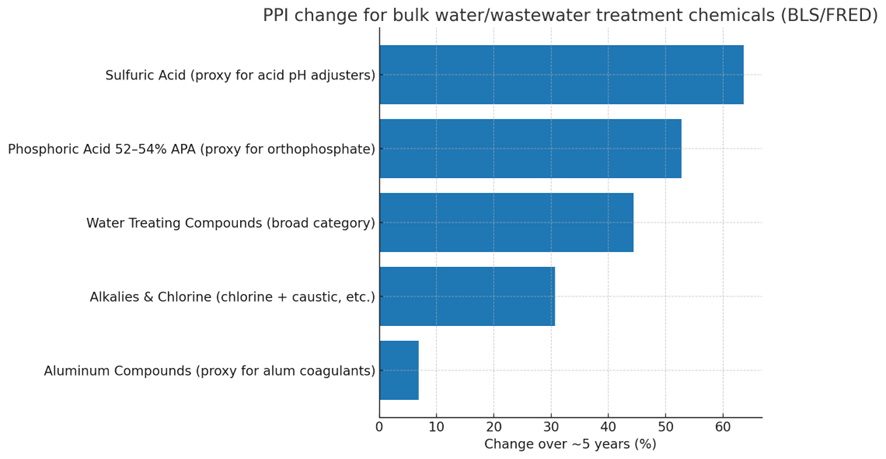
Across the water sector, utilities are facing mounting pressure from rising operational costs. One of the biggest drivers apart from inflating energy costs is the increasing price of bulk chemicals used in conventional water and wastewater treatment. In the past five years, common bulk chemicals such as coagulants (+6.8%), disinfectants (30.7%), pH adjusters (63.6%), and corrosion control agents (52.8%) have increased dramatically (Figure 1). These chemicals are essential to meeting regulatory requirements and ensuring safe, reliable water services. Yet, their growing expense poses financial, operational, and compliance challenges.
Figure 1 – plot indicating how prices for various bulk water and wastewater treatment chemicals have risen since 2020 according to producer price index (PPI) values as a proxy.

Several factors are fueling this trend. Global supply chain disruptions have created volatility in chemical availability and pricing. Transportation costs remain high, and raw material shortages continue to be felt across the market. On top of that, stricter regulatory requirements such as more stringent nutrient removal requirements in wastewater and changes to disinfection byproduct control and emerging contaminant mitigation in the water market are expected to lead to higher chemical consumption, adding to utilities’ operating expenses. Together, these pressures put utilities in the difficult position of balancing affordability with the obligation to protect public health and the environment.
The stakes go beyond budgets. Bulk chemical handling also carries inherent safety and environmental risks. Improper storage, dosing, or monitoring can result in compliance violations, equipment damage, worker safety hazards, or accidental releases. For utilities operating under increasingly tight margins, a mismanaged chemical program can quickly become both a financial liability and a regulatory risk.
This is why utilities are turning to better strategies for chemical management. Approaches such as improved inventory tracking, predictive purchasing, automated dosing controls, and data-driven optimization can help reduce waste, improve safety, and ensure compliance while curbing costs. At Locus Technologies our chemical inventory application (link to PR) allows users to maintain dynamic chemical inventories from receiving to disposal. Users can streamline regulatory reporting with built-in templates for EPCRA Tier II and Toxic Release Inventory (TRI) submissions and monitor consumption data and other KPIs in a purpose-built dashboard.
Ultimately, the challenge of rising chemical costs is a reminder that water and wastewater treatment is not only about technology—it’s about management. By treating bulk chemicals as strategic assets rather than commodities, utilities can protect their bottom line, safeguard workers and communities, and continue to meet the vital responsibility of delivering clean, safe water.
Laura Underwood, PhD
Director of Digital Water Services, Locus Technologies
Dr. Underwood brings over two decades of leadership in the water and environmental sectors, most recently serving as Senior Director of Strategy & Innovation at Veolia. She has also held key roles in water utility management, including serving as the Director of Water Quality & Environmental Compliance for a Municipal Water business unit. A long-time contributor to the American Water Works Association (AWWA) and a passionate advocate for digital transformation, Laura has built a national reputation for advancing smart, sustainable water practices across the utility and industrial landscapes.
Locus is the only self-funded water, air, soil, biological, energy, and waste EHS software company that is still owned and managed by its founder. The brightest minds in environmental science, embodied carbon, CO2 emissions, refrigerants, and PFAS hang their hats at Locus, and they’ve helped us to become a market leader in EHS software. Every client-facing employee at Locus has an advanced degree in science or professional EHS experience, and they incubate new ideas every day – such as how machine learning, AI, blockchain, and the Internet of Things will up the ante for EHS software, ESG, and sustainability.




